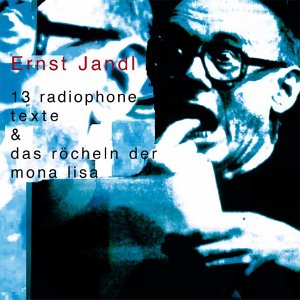Difference between revisions of "13 Radiophone Texte"
Martinwguy (talk | contribs) |
Martinwguy (talk | contribs) |
||
| Line 4: | Line 4: | ||
The piece also gets called [[Jandl]]. | The piece also gets called [[Jandl]]. | ||
| − | < | + | |
| + | <BLOCKQUOTE> | ||
In the late '60s, Jandl was given the chance to experiment with recording equipment. In "13 Radiophone Texte" and "Das Röchelm der Mona Lisa," the poet's voice is multi-tracked, processed (speed variation, reverb, ring modulation, etc.), and edited into impressive sound pieces that still pack some shock value decades later. The 13 radio texts were produced at the BBC in 1966. [...] They consist of phonetic explorations of simple phrases and make stunning use of extended vocal techniques. The 13 vignettes total 27 minutes in duration.<ref name=allmusic/> | In the late '60s, Jandl was given the chance to experiment with recording equipment. In "13 Radiophone Texte" and "Das Röchelm der Mona Lisa," the poet's voice is multi-tracked, processed (speed variation, reverb, ring modulation, etc.), and edited into impressive sound pieces that still pack some shock value decades later. The 13 radio texts were produced at the BBC in 1966. [...] They consist of phonetic explorations of simple phrases and make stunning use of extended vocal techniques. The 13 vignettes total 27 minutes in duration.<ref name=allmusic/> | ||
| − | </ | + | </BLOCKQUOTE> |
| + | |||
| + | <BLOCKQUOTE> | ||
| + | At the great poetry reading at the Albert Hall on June the 11th, 1965 | ||
| + | the most popular event of all was a reading by the Austrian poet Ernst Jandl | ||
| + | of a number of his sound poems [...] due to [...] the very intense emotive power of language used | ||
| + | in the border area between poetry and music. The BBC Radiophonic Workshop | ||
| + | has already experimented in this area with recent programmes of sound poems | ||
| + | by Bob Cobbing and orchestrations of poetry with electronic sounds under the | ||
| + | direction of Rosemary Tonks. | ||
| + | <BR> Well, this evening you're going to hear perhaps the most extreme development | ||
| + | of this technique so far. Ernst Jandl has been working for several days with | ||
| + | a team of people at the Radiophonic Workshop on a sound treatment of a | ||
| + | sequence of his poems in the original German.<ref>Spoken introduction to the first radio broadcast, 13th December 1966.</ref> | ||
| + | </BLOCKQUOTE> | ||
=Availability= | =Availability= | ||
Revision as of 20:23, 7 July 2016
Delia is credited with music for a radio programme German Concrete Poetry (Ernst Jandl) produced by George MacBeth. The notes to its Radiophonic Database entry for tape TRW 6496, dated 1st June 1966, read: "Laut Und Luise" - Poems of Ernst Jandl,[1] where Laut Und Luise is a book of Ernst Jandl's poems published in 1966.[2]
The piece also gets called Jandl.
In the late '60s, Jandl was given the chance to experiment with recording equipment. In "13 Radiophone Texte" and "Das Röchelm der Mona Lisa," the poet's voice is multi-tracked, processed (speed variation, reverb, ring modulation, etc.), and edited into impressive sound pieces that still pack some shock value decades later. The 13 radio texts were produced at the BBC in 1966. [...] They consist of phonetic explorations of simple phrases and make stunning use of extended vocal techniques. The 13 vignettes total 27 minutes in duration.[3]
At the great poetry reading at the Albert Hall on June the 11th, 1965 the most popular event of all was a reading by the Austrian poet Ernst Jandl of a number of his sound poems [...] due to [...] the very intense emotive power of language used in the border area between poetry and music. The BBC Radiophonic Workshop has already experimented in this area with recent programmes of sound poems by Bob Cobbing and orchestrations of poetry with electronic sounds under the direction of Rosemary Tonks.
Well, this evening you're going to hear perhaps the most extreme development of this technique so far. Ernst Jandl has been working for several days with a team of people at the Radiophonic Workshop on a sound treatment of a sequence of his poems in the original German.[4]
Availability
- Broadcast on 13th December 1966 at 10.05pm on the BBC's Third Programme.[1]
- Broadcast on 25th September 1968 at 8.40pm on BBC Radio 3.[5]
- In the BBC Sound Archive on tapes TRW 6496[1] and TRW 6931.[6]
- An excerpt is on TRW 7059.[5]
- A copy of the poem Niagara Falls is on tape TRW 5.[1]
- Published on audio cassette and on CD, e.g. on abebooks.co.uk or on Amazon
- Published in 2002 by Intermedium on CD Ernst Jandl: 13 Radiophone Texte & Das Roecheln der Mona Lisa.[3]
- On radioartnet.bandcamp.com
References
- ↑ 1.0 1.1 1.2 1.3 The Tape Library List's entry for TRW 6496.
- ↑ Laut und Luise on de.wikipedia.org
- ↑ 3.0 3.1 Review of Ernst Jandl: 13 Radiophone Texte &... on allmusic.com
- ↑ Spoken introduction to the first radio broadcast, 13th December 1966.
- ↑ 5.0 5.1 The Tape Library List's entry for TRW 6931.
- ↑ The Tape Library List's entry for TRW 6931.
